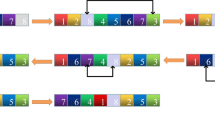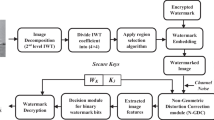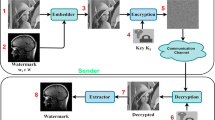Abstract
A turtle shell (TS) based reversible data hiding (RDH) scheme with two-dimensional histogram shifting (HS) is proposed. The proposed scheme extends the embeddable set from a peak point in HS scheme to a two-dimensional region, so as to improve the embedding capacity (EC). Firstly, a threshold T is used to divide the pixel-pairs into three groups: left-shifting set without embedding (LSS), right-shifting set without embedding (RSS), and embeddable set (ES). Secondly, pixel-pairs in sets LSS and RSS are shifted outward to vacate room for embedding. Lastly, secret data are embedded into pixel-pairs in set ES. After that, the embedded data can be extracted accurately and the cover image can be recovered losslessly. Furthermore, various requirements of EC can be obtained by adjusting the threshold T. Experimental results verify that this paper can achieve a higher EC than the existing pairwise based schemes while maintaining an acceptable image quality.













Similar content being viewed by others
References
Petitcolas FAP, Anderson RJ, Kuhn MG (1999) Information hiding — a survey. Proc IEEE 87(7):1062–1078
Mielikainen J (2006) LSB matching revisited. IEEE Signal Proc Lett 13(5):285–287
Ker AD (2004) Improved detection of LSB steganography in grayscale images. Proc Inform Hiding Workshop 3200:97–115
Zhang X, Wang S (2006) Efficient steganographic embedding by exploiting modification direction. IEEE Commun Lett 10(11):781–783
Kim HJ, Kim C, Choi Y (2010) Improved modification direction methods. Comput MathAppl 60(2):319–325
Chang CC, Chou YC, Kieu TD (2008) “An information hiding scheme using Sudoku,” proceedings of the third international conference on innovative computing information and control. Dalian, China, pp 17–22
Chang CC, Liu Y, Nguyen TS (2014) “A novel turtle shell based scheme for data hiding,” intelligent information hiding and multimedia signal processing (IIH-MSP), 2014 tenth international conference on. IEEE. Kitakyushu, Japan, pp 89–93
Liu L, Chang CC, Wang A (2017) Data hiding based on extended turtle shell matrix construction method. Multimed Tools Appl 76(10):12233–12250
Barton JM (1997) “Method and apparatus for embedding authentication information within digital data,” U.S. Patent 5(646):997
Tian J (2003) Reversible data embedding using a difference expansion. IEEE Trans Circuits Syst Video Technol 13(8):890–896
Alattar AM (2004) Reversible watermark using the difference expansion of a generalized integer transform. IEEE Trans Image Process 13(8):1147–1156
Lin CC, Yang SP, Hsueh NL (2008) Lossless data hiding based on difference expansion without a location map. In: Proceedings of congress on image and signal processing (CISP '08), pp 8–12
Kim HJ, Sachnev V, Shi YQ, Nam J, Choo HG (2008) A novel difference expansion transform for reversible data embedding. IEEE Trans Inform Forensics Sec 3:456–465
Ni Z, Shi YQ, Ansari N, Wei S (2006) “Reversible data hiding,” IEEE transactions on circuits and Systems for Video. Technology 16(3):354–362
Zhao Z, Luo H, Lu ZM, Pan JS (2011) Reversible data hiding based on multilevel histogram modification and sequential recovery. AEU – Int J Electron Commun 65(10):814–826
Yan Y, Cao W, Li S (2009) High capacity reversible image authentication based on difference image watermarking. Proc IEEE Int Workshop Image Syst Tech:179–182
Li X, Zhang W, Gui X, Yang B (2013) A novel reversible data hiding scheme based on two-dimensional difference-histogram modification. IEEE Trans Inform Forensics Sec 8:1091–1110
Hong W, Chen TS, Shiu CW (2009) Reversible data hiding for high quality images using modification of prediction errors. J Syst Softw 82(11):1833–1842
Chen S, Chen X, Fu H (2017) General framework of reversible watermarking based on asymmetric histogram shifting of prediction error. Adv Multimed 2017:1–9
Ou B, Li X, Zhao Y, Ni R, Shi YQ (2013) Pairwise prediction-error expansion for efficient reversible data hiding. IEEE Trans Image Process 22:5010–5021
Hsiao JY, Lin ZY, Chen PY (2017) Reversible data hiding based on pairwise prediction-error histogram. J Inform Sci Eng 33(2):289–304
He W, Xiong G, Weng S et al (2018) Reversible data hiding using multi-pass pixel-value-ordering and pairwise prediction-error expansion. Inf Sci:1–16
Cao F, An B, Yao H et al (2018) Local complexity based adaptive embedding mechanism for reversible data hiding in digital images. Multimed Tools Appl:1–16
Li X, Li B, Yang B, Zeng T (2013) General framework to histogram-shifting-based reversible data hiding. IEEE Trans Image Process 22(6):2181–2191
Wang ZH, Lee CF, Chang CY (2013) Histogram-shifting-imitated reversible data hiding. J Syst Softw 86(2):315–323
Kim PH, Kim DS, Yoo KY (2015) “Improved histogram-shifting-imitated reversible data hiding scheme,” proceedings of information technology-new generations. Las Vegas, USA, pp 668–673
Fridrich J, Goljan M, Du R (2002) Lossless data embedding for all image formats. Sec Watermark Multimed Cont IV 4675:572–583
Celik MU, Sharma G, Tekalp AM, Saber E (2005) Lossless generalized-LSB data embedding. IEEE Trans Image Process 14(2):253–266
Celik MU, Sharma G, Tekalp AM (2006) Lossless watermarking for image authentication: a new framework and an implementation. IEEE Trans Image Process 15(4):1042–1049
Liu Y, Chang CC (2018) A turtle shell-based visual secret sharing scheme with reversibility and authentication. Multimed Tools Appl 3:1–16
The USC-SIPI Image Database [Online]. Available: http://sipi.usc.edu/database/
Acknowledgements
This work is supported by Natural Science Foundation of P. R. China under Grant 61503316, Natural Science Foundation of Fujian Province under Grant 2018 J01572 and Open Fund of Engineering Research Center for Software Testing and Evaluation of Fujian Province.
Author information
Authors and Affiliations
Corresponding author
Additional information
Publisher’s note
Springer Nature remains neutral with regard to jurisdictional claims in published maps and institutional affiliations.
Rights and permissions
About this article
Cite this article
Xie, XZ., Chang, CC., Lin, CC. et al. A Turtle Shell based RDH scheme with two-dimensional histogram shifting. Multimed Tools Appl 78, 19413–19436 (2019). https://doi.org/10.1007/s11042-018-7098-7
Received:
Revised:
Accepted:
Published:
Issue Date:
DOI: https://doi.org/10.1007/s11042-018-7098-7




